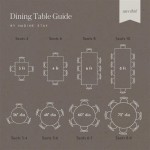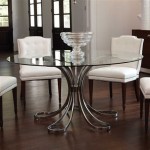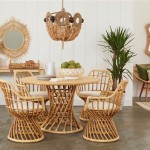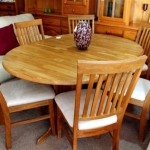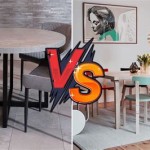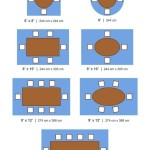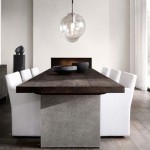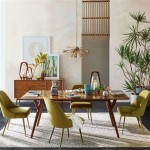Outdoor Dining Table 8 Seater: A Comprehensive Guide
The outdoor dining table, specifically one designed to accommodate eight individuals, represents a significant investment in enhancing the functionality and aesthetic appeal of outdoor living spaces. These tables serve as central gathering points for meals, social events, and relaxation, fostering a sense of community and connection with nature. Selecting the appropriate outdoor dining table for eight requires careful consideration of several factors, including material durability, design aesthetics, spatial constraints, and budget considerations.
This article provides a detailed overview of the key aspects to consider when choosing an outdoor dining table 8 seater, aiming to equip prospective buyers with the knowledge necessary to make an informed decision. The information presented encompasses material options, design styles, size and shape considerations, maintenance requirements, and factors influencing pricing. Understanding these elements is crucial for selecting a table that not only meets practical needs but also complements the overall design of the outdoor environment and withstands the elements for years to come.
Material Considerations for Outdoor Dining Tables
The choice of material is paramount when selecting an outdoor dining table. The material directly impacts the table's durability, weather resistance, aesthetic appeal, and maintenance requirements. Several material options are commonly available, each with its own set of advantages and disadvantages.
Teak: Teak is highly regarded for its natural durability and resistance to weather, insects, and decay. Its high oil content makes it naturally water-resistant, allowing it to withstand exposure to rain, sun, and humidity. Teak weathers to a beautiful silver-gray patina over time if left untreated, providing a classic and sophisticated aesthetic. While teak is a premium material, its long-term durability and minimal maintenance often justify the higher initial investment. Regular cleaning with soap and water is typically sufficient to maintain its appearance. Oiling the teak can help preserve its original golden color if desired, but it is not necessary for structural integrity.
Aluminum: Aluminum is a popular choice for outdoor furniture due to its lightweight nature, resistance to rust and corrosion, and relatively low cost. Powder-coated aluminum provides an extra layer of protection against the elements, enhancing its durability and preventing chipping or fading. Aluminum tables are easy to clean and require minimal maintenance. They are also available in a wide range of styles and finishes, making them adaptable to various design aesthetics. While aluminum is generally durable, it can be prone to dents and scratches if subjected to significant impact. In windy conditions, lighter aluminum tables may require anchoring to prevent them from being blown over.
Wicker: Wicker, traditionally made from natural materials like rattan, has been largely replaced by synthetic wicker in outdoor furniture applications. Synthetic wicker, typically made from polyethylene or PVC, offers superior weather resistance and durability compared to its natural counterpart. It is resistant to fading, cracking, and rotting, making it suitable for outdoor use in various climates. Wicker tables often feature intricate designs and textures, adding visual interest to outdoor spaces. Regular cleaning with soap and water is usually sufficient to maintain synthetic wicker furniture. However, it is important to protect wicker tables from prolonged exposure to direct sunlight, as this can cause the material to become brittle over time.
Concrete: Concrete dining tables offer a contemporary and industrial aesthetic. They are incredibly durable and resistant to weather, making them a long-lasting option for outdoor use. Concrete tables are also heavy and stable, making them resistant to being blown over in windy conditions. However, their weight can also make them difficult to move. Concrete is a porous material and should be sealed to prevent staining from spills. Regular cleaning with a mild detergent is recommended to maintain its appearance. Concrete tables can be expensive and may require professional installation due to their weight.
Wood (Other than Teak): Various other wood species, such as eucalyptus, acacia, and shorea, are also used in outdoor dining tables. These woods are generally less expensive than teak but require more maintenance to protect them from the elements. Regular sealing and staining are necessary to prevent warping, cracking, and decay. The lifespan of tables made from these woods is typically shorter than that of teak tables. It is important to choose responsibly sourced wood and to follow the manufacturer's recommendations for maintenance to prolong the life of the table.
Design Styles and Shape Considerations
Beyond material selection, the design style and shape of the outdoor dining table plays a crucial role in determining its overall aesthetic appeal and functionality within the outdoor space. The design should complement the existing architectural style of the home and the surrounding landscape.
Traditional: Traditional outdoor dining tables often feature classic designs with ornate details, such as carved legs, scrolled backs, and rich finishes. These tables are typically made from wood, such as teak or mahogany, and evoke a sense of timeless elegance. Traditional designs are well-suited for formal outdoor settings and gardens.
Modern: Modern outdoor dining tables are characterized by clean lines, minimalist designs, and a focus on functionality. Materials such as aluminum, stainless steel, and concrete are commonly used in modern designs. Modern tables often feature sleek profiles and geometric shapes, creating a contemporary and sophisticated look. These tables are well-suited for modern homes and urban outdoor spaces.
Rustic: Rustic outdoor dining tables embrace natural materials and textures, often featuring reclaimed wood, rough-hewn surfaces, and earthy tones. These tables evoke a sense of warmth and informality, creating a relaxed and inviting atmosphere. Rustic designs are well-suited for country homes and natural settings. They often incorporate elements like exposed hardware and distressed finishes to enhance their rustic charm.
Round vs. Rectangular vs. Oval: The shape of the table influences both its aesthetic appeal and its functionality. Round tables promote conversation and create a more intimate dining experience. They are well-suited for smaller outdoor spaces. Rectangular tables are more formal and provide ample seating space, making them ideal for larger gatherings. Oval tables offer a compromise between round and rectangular shapes, providing ample seating while still promoting conversation. The choice of shape should be based on the size of the space, the desired aesthetic, and the intended use of the table.
Extending Tables: Extending tables offer versatility by allowing the table to be expanded to accommodate additional guests when needed. These tables are ideal for those who frequently entertain but do not have the space for a large table on a permanent basis. Extending tables typically feature a hidden leaf or leaves that can be easily added or removed to adjust the table's size. It is important to ensure that the extension mechanism is smooth and easy to operate.
Maintenance and Care for Outdoor Dining Tables
Proper maintenance and care are essential for prolonging the lifespan of an outdoor dining table and preserving its appearance. The specific maintenance requirements vary depending on the material of the table.
Teak Maintenance: Teak requires minimal maintenance. Regular cleaning with soap and water is sufficient to remove dirt and debris. If the table is left untreated, it will gradually weather to a silver-gray patina. This is a natural process that does not affect the structural integrity of the wood. If it is desired to maintain the original golden color, the table can be oiled periodically with teak oil. Avoid using harsh chemicals or abrasive cleaners, as these can damage the wood.
Aluminum Maintenance: Aluminum tables are easy to clean and require minimal maintenance. Regular cleaning with soap and water is sufficient to remove dirt and debris. Powder-coated aluminum is resistant to chipping and fading, but it is important to avoid using abrasive cleaners that can scratch the finish. Any scratches or dents should be repaired promptly to prevent corrosion.
Wicker Maintenance: Synthetic wicker tables can be cleaned with soap and water. A soft brush can be used to remove dirt and debris from the crevices. Avoid using harsh chemicals or abrasive cleaners. While synthetic wicker is resistant to fading, prolonged exposure to direct sunlight can cause it to become brittle over time. Consider using furniture covers or storing the table indoors during periods of prolonged sun exposure.
Concrete Maintenance: Concrete tables should be sealed to prevent staining from spills. Regular cleaning with a mild detergent is recommended. Avoid using harsh chemicals or abrasive cleaners. Any stains should be cleaned up promptly to prevent them from setting. Concrete is a porous material and can crack if exposed to freezing temperatures. Consider covering the table or storing it indoors during the winter months in colder climates.
Wood (Other than Teak) Maintenance: Tables made from other wood species require more maintenance than teak tables. Regular sealing and staining are necessary to protect the wood from the elements. Follow the manufacturer's recommendations for maintenance. Sanding and re-staining may be required periodically to maintain the appearance of the table. Avoid using harsh chemicals or abrasive cleaners.
General Maintenance Tips: Regardless of the material, it is important to cover the table or store it indoors during periods of inclement weather or prolonged non-use. This will help to protect it from the elements and prolong its lifespan. Regularly inspect the table for any signs of damage, such as cracks, chips, or rust. Repair any damage promptly to prevent it from worsening. Keep the table clean and free of debris. Use placemats and coasters to protect the surface from spills and scratches.
Investing in an outdoor dining table 8 seater is a significant decision that requires careful planning and consideration. By understanding the different material options, design styles, and maintenance requirements, it is possible to select a table that meets practical needs, complements the outdoor space, and provides years of enjoyment. Careful consideration should be given to the spatial constraints of the area where the table will be placed, ensuring that there is ample room for seating and movement around the table. The budget should also be taken into account, as prices can vary significantly depending on the material and design.
Before making a purchase, it is advisable to visit several retailers and compare different models. Reading online reviews and seeking recommendations from friends and family can also be helpful. It is important to choose a reputable retailer that offers a warranty on the table. Taking the time to research and compare different options will ensure that the selected outdoor dining table 8 seater is a worthwhile investment that enhances the outdoor living experience.

Timor Outdoor Dining Table 8 Seater Grey Teak And Anthracite Aluminium

Timor Outdoor Dining Table 8 Seater Teak With Aluminium Frame W260

Chateau 9 Piece Dining Set 60 X 84 Weave Table And 8 Chairs

Nevada Outdoor Dining Table 8 Seater Teak With Aluminium Frame W320

Oval Extending Dining Table Set 8 Seater Teak Sloane Sons

Teak Outdoor Extending Dining Table Set 8 Seater Sloane Sons

Edge Outdoor Fabric 8 Seat Round Dining Set

Mf Studio 9 Piece Outdoor Patio Dining Set With Metal Extendable Table And 8 Rattan Chairs For Yard Porch Wal Com

Genoa Outdoor Fabric 8 Seat Rectangular Dining Set With Firepit

Teak Dining Set 8 Seater 9 Pc 94 Double Extension Rectangle Table And Sack Arm Chairs Outdoor Patio Grade A Wood Wholeteak Wmdssk6 Wal Com

